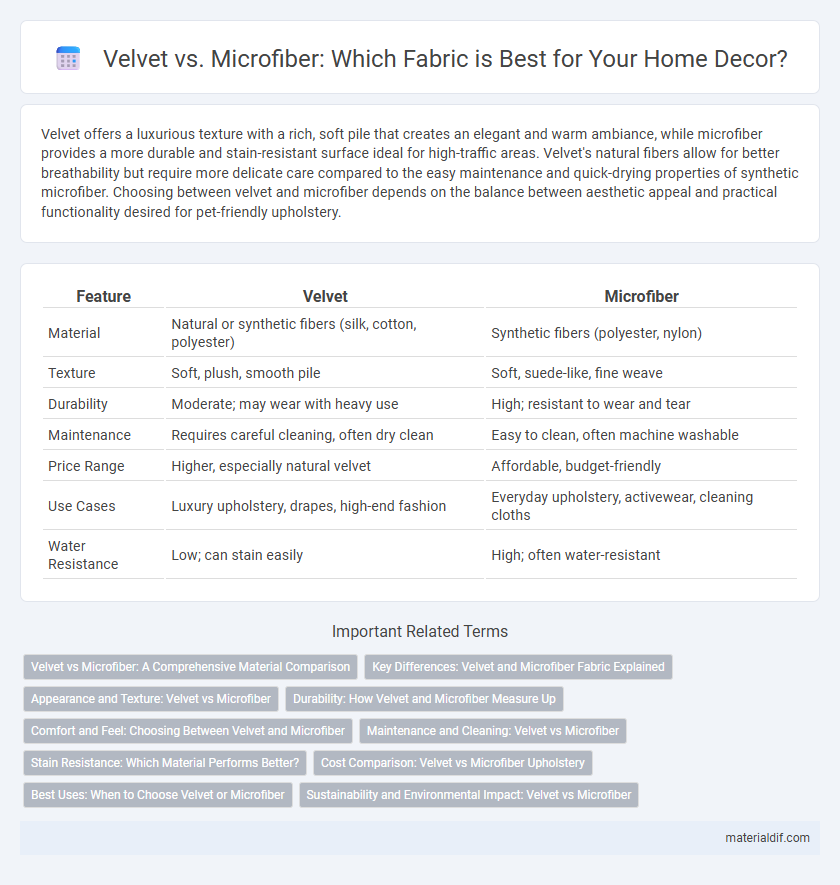Velvet offers a luxurious texture with a rich, soft pile that creates an elegant and warm ambiance, while microfiber provides a more durable and stain-resistant surface ideal for high-traffic areas. Velvet's natural fibers allow for better breathability but require more delicate care compared to the easy maintenance and quick-drying properties of synthetic microfiber. Choosing between velvet and microfiber depends on the balance between aesthetic appeal and practical functionality desired for pet-friendly upholstery.
Table of Comparison
| Feature | Velvet | Microfiber |
|---|---|---|
| Material | Natural or synthetic fibers (silk, cotton, polyester) | Synthetic fibers (polyester, nylon) |
| Texture | Soft, plush, smooth pile | Soft, suede-like, fine weave |
| Durability | Moderate; may wear with heavy use | High; resistant to wear and tear |
| Maintenance | Requires careful cleaning, often dry clean | Easy to clean, often machine washable |
| Price Range | Higher, especially natural velvet | Affordable, budget-friendly |
| Use Cases | Luxury upholstery, drapes, high-end fashion | Everyday upholstery, activewear, cleaning cloths |
| Water Resistance | Low; can stain easily | High; often water-resistant |
Velvet vs Microfiber: A Comprehensive Material Comparison
Velvet offers a luxurious texture with a dense pile made from natural fibers like cotton or silk, providing a soft, rich feel that enhances elegance in upholstery and fashion. Microfiber, composed of tightly woven synthetic fibers such as polyester, excels in durability, stain resistance, and easy maintenance, making it ideal for high-traffic environments. Comparing velvet and microfiber highlights the trade-off between velvet's premium aesthetics and microfiber's practical performance in everyday use.
Key Differences: Velvet and Microfiber Fabric Explained
Velvet features a plush, dense pile made from natural fibers like silk or cotton, offering a rich texture and luxurious appearance, whereas microfiber is a synthetic fabric composed of ultra-fine polyester or nylon fibers designed for durability and stain resistance. Velvet's texture yields a soft, tactile feel with a slight sheen that enhances its opulence, while microfiber's tightly woven fibers provide a smooth, uniform surface ideal for easy cleaning and everyday use. The key differences lie in velvet's natural fiber composition and sumptuous look versus microfiber's synthetic, practical attributes suited for high-traffic environments.
Appearance and Texture: Velvet vs Microfiber
Velvet boasts a rich, lustrous sheen and a plush, soft texture that enhances visual depth and tactile luxury in upholstery and fashion. Microfiber, while less shiny, offers a smooth, consistent surface with a fine weave that resists wear and maintains a sleek, modern appearance. The distinctive pile of velvet creates a dynamic play of light and shadow, whereas microfiber's uniform fibers provide durability and ease of maintenance.
Durability: How Velvet and Microfiber Measure Up
Velvet offers luxurious texture and durability, especially when made from synthetic fibers like polyester, which resist wear and maintain their appearance over time. Microfiber, composed of densely woven synthetic fibers, excels in resistance to stains, abrasions, and fading, making it highly durable for everyday use. Both materials are durable, but microfiber generally outperforms velvet in extreme durability and ease of maintenance.
Comfort and Feel: Choosing Between Velvet and Microfiber
Velvet offers a luxurious, soft texture that feels rich and plush against the skin, making it ideal for creating a cozy, elegant ambiance. Microfiber provides a smooth, lightweight feel that is breathable and easy to maintain, often preferred for practical comfort and durability. When choosing between velvet and microfiber, prioritize whether you value the tactile sophistication of velvet or the versatile, low-maintenance comfort of microfiber.
Maintenance and Cleaning: Velvet vs Microfiber
Velvet requires gentle maintenance, including regular vacuuming and professional cleaning to preserve its texture and prevent crushing, while microfiber is highly stain-resistant and easier to clean with simple spot treatments or machine washing. Velvet's delicate fibers can attract dust and oils, necessitating careful handling, whereas microfiber's synthetic composition repels dirt and dries quickly, making it suitable for a busy household. Choosing microfiber over velvet prioritizes low-maintenance durability without sacrificing a soft, plush feel.
Stain Resistance: Which Material Performs Better?
Velvet and microfiber differ significantly in stain resistance, with microfiber showing superior performance due to its synthetic fibers that repel liquids and resist stains more effectively than natural velvet. Velvet, often made from cotton or silk blends, tends to absorb spills quickly, making stain removal more challenging. For upholstery or clothing exposed to frequent contact with liquids or dirt, microfiber offers a more practical, stain-resistant option.
Cost Comparison: Velvet vs Microfiber Upholstery
Velvet upholstery generally commands a higher price than microfiber due to its luxurious texture and complex manufacturing process. Microfiber offers an affordable alternative with durable synthetic fibers, making it cost-effective for budget-conscious consumers. Comparing longevity, microfiber tends to require less maintenance, providing better overall value despite the initial lower expense of velvet.
Best Uses: When to Choose Velvet or Microfiber
Velvet excels in luxury home decor and formal settings due to its rich texture and elegant appearance, making it ideal for accent chairs, sofas, and drapery that require a sophisticated look. Microfiber offers superior durability and stain resistance, perfect for high-traffic areas, families with pets, or casual furniture where easy maintenance and longevity are priorities. Choose velvet for aesthetic appeal and opulent ambiance, while microfiber suits practical, everyday use demanding resilience and ease of cleaning.
Sustainability and Environmental Impact: Velvet vs Microfiber
Velvet, typically made from natural fibers like cotton or silk, offers enhanced sustainability compared to synthetic microfiber, which derives from petroleum-based materials contributing to microplastic pollution. Velvet's biodegradable properties reduce long-term environmental impact, while microfiber's production and disposal often result in significant carbon emissions and water contamination. Choosing velvet supports eco-friendly textile practices by promoting renewability and reducing dependence on non-renewable resources.
Velvet vs Microfiber Infographic

 materialdif.com
materialdif.com